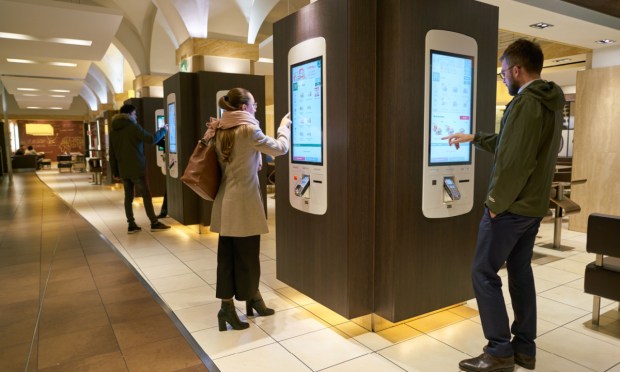Restaurants Split on Kiosks in Efforts to Boost Digital Efficiency

As consumers’ digital expectations come to influence how they engage with physical stores, restaurants are investing in new on-premises capabilities, but when it comes to self-service kiosks, major brands are split.
Most recently, fast-casual salad chain Chopt opened an all-digital location in New York City, QSR noted, where consumers order at self-service kiosks for off-premises or via their own devices from on-table QR codes for dine-in.
The news comes as leading restaurants remain split on whether kiosks are a valuable investment or whether they are an unnecessary expense given the widespread availability of own-device ordering capabilities.
Fast-casual burger chain Shake Shack, for one, falls firmly on the pro-kiosk side.
“We grew in-Shack, same store sales by more than 20% year over year and more than doubled our total Kiosk sales versus last year,” CFO Katherine Fogerty told analysts on the company’s earnings call Thursday (May 4). “Putting kiosks into our Shacks is another key way we have identified to improve our sales and profitability, and we shared a goal last year to roll out Kiosk nearly all Shacks by the end of 2023. We are proud to report that we are executing ahead of this timeline.”
Meanwhile, quick-service restaurant (QSR) giant Restaurant Brands International (RBI), parent company of Burger King, Tim Hortons, Popeyes and Firehouse Subs, said Tuesday (May 2) on its earnings call that, in some cases, kiosks are already outdated. CEO Josh Kobza noted that, while France has seen kiosks as the “biggest driver” of digital sales, and Australia has seen “strong adoption” of kiosks, China has seen very different results.
“In China, where the front counter POS is becoming less relevant, … nearly all orders can be online channels,” Kobza said. “Some brands are even beginning to sunset their kiosk programs and transition entirely to mobile ordering. Whatever the format and their local markets, what is clear is that quick service restaurants are moving towards automated ordering.”
These efforts come as consumers continue to primarily order restaurant meals in store, but the mix is shifting away from on-premises dining. Research from PYMNTS’ study “Connected Dining: Rising Costs Push Consumers Toward Pickup,” for which we surveyed more than 2,100 U.S. consumers earlier this year about their restaurant dining habits, revealed that 51% of consumers had their most recent meal inside the restaurant. In contrast, 39% ordered for pickup and 10% for delivery.
This suggests a significant decrease in on-premises dining from last year, when PYMNTS data revealed that 78% of diners’ most recent orders were made inside the restaurant, paying a human employee. At that time, 7% of diners reported that their most recent purchase was placed in-person through an automated kiosk.
Kiosks, for their part, appear to have a prominent role in the future of QSRs and fast-casual brands, but when it comes to full-service restaurants (FSRs), it seems consumers are unwilling to shift the experience digital.
Data from PYMNTS’ study, “The Digital Divide: Technology, the Metaverse and the Future of Dining Out,” which drew from a survey of about 2,500 U.S. consumers, revealed that 51% of grab-and-go customers said ordering through a self-service kiosk would positively impact their satisfaction, while only 20% of dine-in customers said the same.

